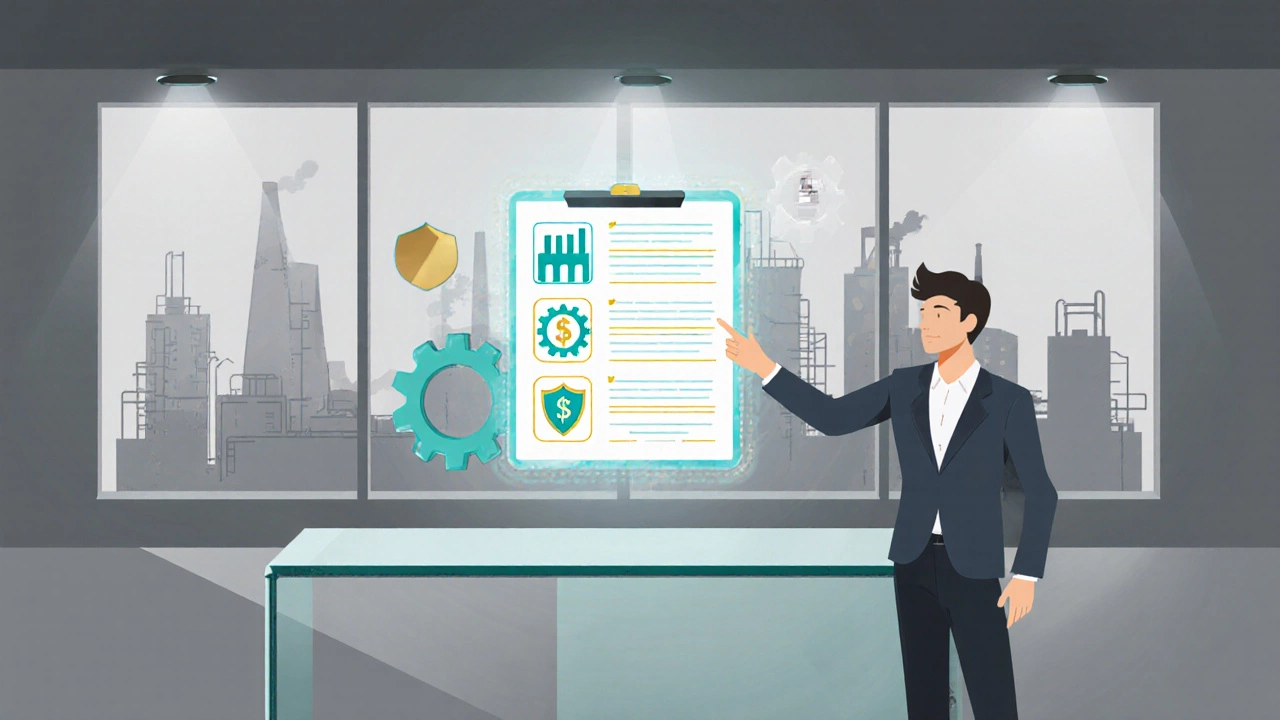Manufacturing Profitability Assessment Tool
Assess Your Manufacturing Sector Potential
Rate your business capabilities against key criteria to discover which manufacturing sectors offer the best profit potential for your situation. Based on 2025 industry data from the British Manufacturing Association and Deloitte.
Rate Your Business Capabilities
Can you afford heavy equipment and large facilities, or need a light-footprint operation?
Do you have access to specialized staff and certifications?
How complex are the licensing and compliance requirements?
Can you reach your target customers directly or need distributors?
Can you expand production without massive retooling?
Trying to pick a manufacturing niche that actually puts money in the bank can feel like hunting for a needle in a haystack. The good news? Data from 2024‑25 shows a clear set of sectors that consistently out‑perform the rest in terms of profit margins, return on investment, and cash flow stability. Below you’ll find a straight‑forward rundown of the top‑earning manufacturing categories, why they command such high returns, and a practical checklist to see if any of them match your resources and risk appetite.
Quick Takeaways
- The most profitable manufacturing segments in 2025 are pharmaceutical, specialty food processing, and high‑tech electronics.
- Average gross profit margins range from 15 % in bulk steel to over 45 % in niche pharma.
- Key profit drivers include regulatory barriers, high entry costs, and fast‑moving consumer demand.
- Small‑scale entrants can still capture strong returns by focusing on customization, sustainability, and data‑driven production.
- Use the checklist at the end to score each sector against your capital, expertise, and market access.
What Exactly Does "Profitability" Mean in Manufacturing?
Before we compare sectors, it helps to pin down the metrics most investors watch:
- Gross profit margin - revenue minus direct production costs, expressed as a percentage.
- Net profit margin - bottom‑line profit after all operating expenses, taxes, and interest.
- Return on Investment (ROI) - net profit divided by total capital deployed.
- Cash conversion cycle - how quickly cash tied up in inventory and receivables turns back into liquid cash.
These figures vary widely because each manufacturing type has a different cost structure. Heavy‑industry plants burn through energy and raw material, while niche pharma spends heavily on R&D and compliance but enjoys premium pricing.
Top High‑Profit Manufacturing Sectors in 2025
Below is a snapshot of the sectors that posted the highest average gross profit margins in the latest industry surveys (British Manufacturing Association, 2025; Deloitte Manufacturing Outlook, 2024). The numbers reflect UK‑based operations but are broadly similar in other advanced economies.
| Sector | Average Gross Profit % | Typical ROI % | Key Profit Drivers |
|---|---|---|---|
| Pharmaceutical manufacturing - produces prescription drugs, biologics, and over‑the‑counter medicines | 45‑55 % | 30‑45 % | Regulatory barriers, high product differentiation, premium pricing |
| Specialty food processing - high‑value items such as organic snacks, plant‑based proteins, and artisanal beverages | 38‑48 % | 25‑35 % | Brand loyalty, health trends, limited competition |
| Electronics manufacturing - produces semiconductors, consumer gadgets, and IoT devices | 30‑40 % | 22‑30 % | Rapid product cycles, high R&D intensity, export demand |
| Automobile manufacturing - assembly of passenger cars, electric vehicles, and commercial trucks | 15‑22 % | 12‑18 % | Scale economies, brand equity, government EV incentives |
| Steel manufacturing - production of raw steel, rolled products, and specialty alloys | 12‑18 % | 10‑15 % | Infrastructure demand, bulk contracts, energy costs |
| Textile manufacturing - fabric weaving, knitting, and garment finishing | 10‑16 % | 8‑12 % | Fast‑fashion cycles, labour costs, sustainability certifications |
| Plastic manufacturing - injection molding, extrusion, and recycling of polymers | 14‑20 % | 11‑16 % | Packaging demand, automotive lightweighting, regulatory pressure |
| Chemical manufacturing - production of industrial chemicals, specialty reagents, and fertilizers | 18‑25 % | 14‑20 % | Process integration, high barriers to entry, long‑term supply contracts |
Why These Sectors Pack More Profit Than Others?
Three common threads explain why the rows above sit ahead of the pack:
- Regulatory or technical barriers keep new competitors out, allowing incumbents to charge premium prices.
- Value‑added processes-think R&D, formulation, or precision engineering-boost the price per unit far beyond raw material cost.
- Strong brand or IP protection turns a commodity into a differentiated product that customers are willing to pay extra for.
In contrast, bulk‑material manufacturers like steel or textiles rely heavily on volume and commodity pricing, which squeezes margins.

How to Choose the Right High‑Profit Segment for Your Business
Even if a sector looks juicy on paper, it must match your own capabilities. Use the following criteria to score each option:
- Capital intensity - Do you have the funds for heavy plant equipment, or would a light‑footprint operation be safer?
- Technical expertise - Some niches (pharma, electronics) need specialist staff and certifications.
- Regulatory landscape - Assess licensing timelines and ongoing compliance costs.
- Market access - Can you reach the target buyers directly, or will you need distributors?
- Scalability - Does the product allow for incremental expansion without a massive re‑tooling?
Assign a score from 1 (low) to 5 (high) for each criterion. Total the points; the highest‑scoring sector is typically the best match for your situation.
Key Risks Across High‑Profit Sectors
Profits can evaporate quickly if you overlook the pitfalls:
- Regulatory changes - A new EU directive on pharma patents or food labeling can force costly reformulation.
- Supply chain volatility - Semiconductor shortages have repeatedly hit electronics makers; raw‑material spikes hit chemicals and plastics.
- Technology obsolescence - In electronics, a product can become outdated within 12‑18 months.
- Consumer trends - Health‑food demand can swing; staying ahead of the curve requires ongoing market research.
- Environmental regulations - Carbon taxes affect steel and chemical plants more than niche food producers.
Mitigation strategies include diversified sourcing, investing in flexible manufacturing lines, and maintaining a compliance team that monitors policy shifts.
Action Checklist: Evaluating a High‑Profit Manufacturing Idea
- Identify the sector you’re interested in and gather the latest profit‑margin data (use industry reports, government statistics, or trade association surveys).
- Map the required capital, equipment, and workforce skill sets. Compare against your available resources.
- Run a risk matrix covering regulatory, supply‑chain, and market‑trend hazards.
- Calculate a 5‑year ROI projection based on realistic sales forecasts and cost assumptions.
- Validate demand by speaking to at least three potential customers or distributors.
- Secure any needed licences or certifications early-delays here are the biggest cost overruns.
- Start with a pilot batch (or a minimum viable product) to test production quality and market response before scaling.
Follow this checklist and you’ll avoid many of the costly missteps that have doomed aspiring manufacturers in the past.
Which manufacturing sector offers the highest gross profit margin?
Pharmaceutical manufacturing leads with average gross profit margins of 45‑55 % in 2025, driven by high product differentiation and strong regulatory protection.

Can a small startup enter a high‑profit sector like pharma?
Yes, but it usually means focusing on niche products such as orphan drugs, nutraceuticals, or contract manufacturing, where capital requirements are lower and the barrier is more about expertise and compliance.
What’s the biggest risk for electronics manufacturers?
Supply‑chain disruption, especially the shortage of advanced semiconductors, can halt production and erode profit margins within weeks.
How do I improve ROI in a low‑margin sector like steel?
Focus on value‑added services such as custom alloy development, just‑in‑time delivery, and recycling streams that capture additional revenue beyond the base metal price.
Is there government support for new manufacturers in the UK?
The UK’s Advanced Manufacturing Fund and regional Innovation Grants provide up to 30 % co‑funding for equipment, R&D, and skills training, especially for high‑tech and low‑carbon processes.
